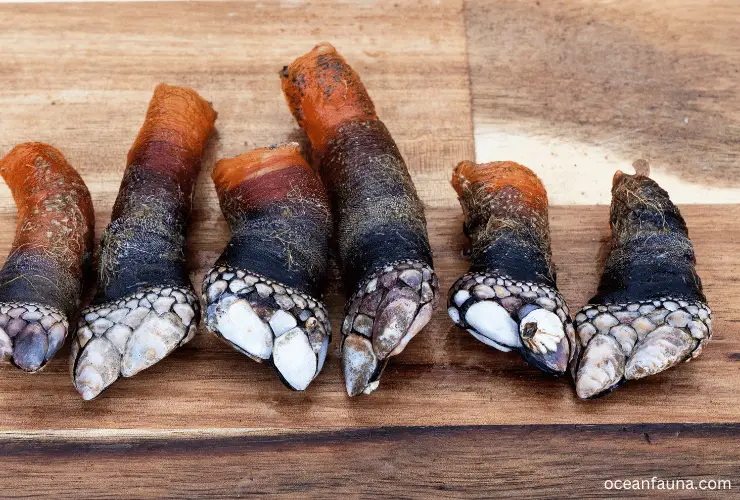Filter-feeding crustaceans, known as gooseneck barnacles, stalked barnacles, or goose barnacles, reside in the ocean’s intertidal zone and attach themselves to the hard surfaces of rocks and flotsam. These barnacles are of the family Lepadidae and are often found in large clusters, forming a carpet-like layer on surfaces.
In this article, I will discuss gooseneck barnacles’ anatomy and life cycle, their habitat, and why they are important to marine ecosystems.
About: Gooseneck Barnacles [In Brief]
Gooseneck barnacles are a type of marine crustaceans that are commonly found along rocky shorelines, as well as on the hulls of ships and other man-made structures that are submerged in the ocean. These strange-looking creatures resemble miniature, elongated volcanoes or chimneys and are characterized by their long, narrow, and flexible stalks that attach them to various substrates.
The body of a gooseneck barnacle is enclosed in a hard, cone-shaped shell composed of several overlapping plates. The shell protects the barnacle from predators, desiccation, and other environmental stresses and can vary in color from white and yellow to brown and black.
Gooseneck barnacles feed on plankton and other small microorganisms that they filter out of the water using their feathery, hair-like appendages called cirri. They are active feeders and can extend and retract their cirri to capture food particles as they drift past.
| Category | Information |
| Scientific name | Pollicipes pollicipes |
| Other name | Goose barnacle, Stalked barnacles |
| Diet | Plankton |
| Habitat | Rocky shores |
| Length | 7-9 cm |
| Lifespan | Up to 20 years |
| Interesting Fact | Gooseneck barnacles are considered a delicacy in many parts of the world, including Spain and Portugal. |
Interestingly, gooseneck barnacles are considered a delicacy in some parts of the world and are harvested for human consumption. They are particularly prized in Spain and Portugal, where they are known as “percebes” and are often served as a high-end seafood dish.
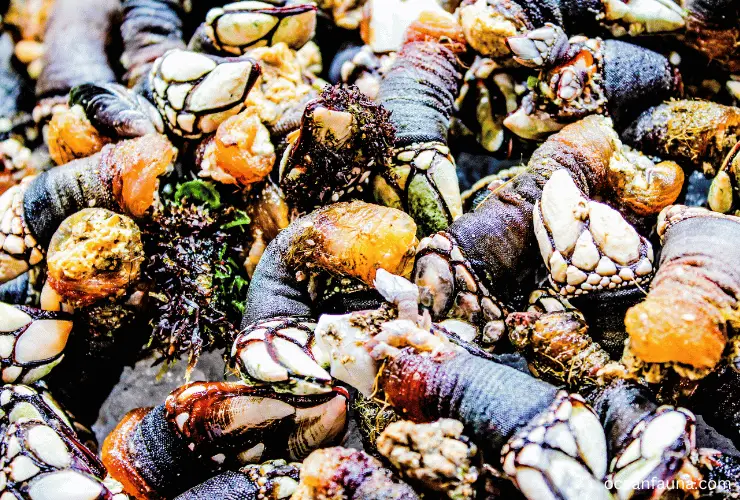
Despite being a food source for humans and other animals, gooseneck barnacles have some fascinating adaptations that allow them to survive in harsh marine environments.
For example, they are able to withstand strong currents and wave action by flexing their stalks and shells or by secreting a glue-like substance to hold onto surfaces.
Anatomy of Gooseneck Barnacle
Gooseneck barnacles are marine animals that belong to the genus Pollicipes. They are a type of sessile crustacean that attaches to rocks or hard surfaces by a fleshy stalk called a peduncle. Here is a detailed description of their anatomical systems:
External morphology
Gooseneck barnacles have cone-shaped shell made up of several plates that are attached to the peduncle. The shell protects the body of the barnacle and its organs from predators and harsh environmental conditions. At the shell’s opening, six pairs of feathery appendages called cirri are used for capturing food and respiration.
Internal anatomy
The internal organs of the gooseneck barnacle are organized in a spiral around the stalk.
The digestive system consists of a mouth, esophagus, stomach, and intestine. The nervous system is made up of a series of ganglia and nerve cords that run along the length of the body.
The reproductive system consists of pairs of gonads that release eggs and sperm into the water.
Respiration
The barnacle’s cirri also play a role in respiration. Oxygenated water enters the shell through the cirri and flows over the respiratory surface, where gas exchange occurs. Carbon dioxide is removed through the cirri as well.
Circulation
Unlike other crustaceans, gooseneck barnacles do not have a complex circulatory system. Instead, they rely on simple diffusion to move gases and other substances throughout their body.
Where Do Gooseneck Barnacles Live?
Gooseneck barnacles are crustaceans typically found on North America’s west coast. Their habitat extends from southeastern Alaska to Baja California, Mexico, and there is even the possibility that they exist further south than that.
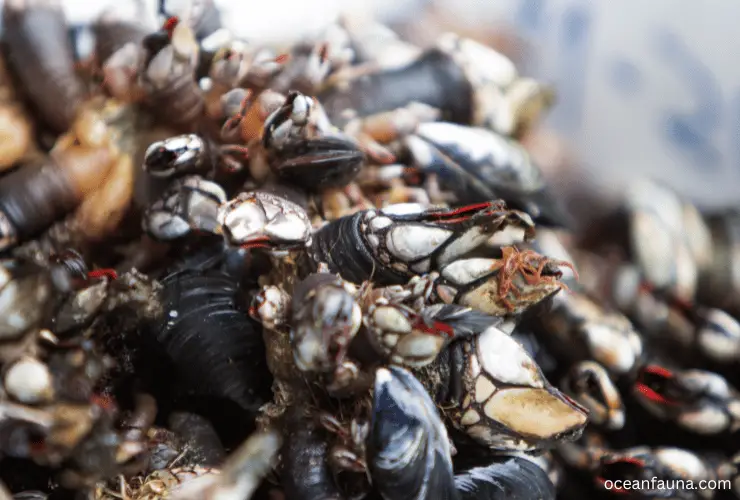
In terms of their specific habitat, these barnacles are known to attach themselves to a range of substrates, including rocks, shells, and even debris, such as plastic garbage or discarded wood.
They can exist in both intertidal zones, the area that is exposed to air during low tide, and subtidal zones, which are always submerged beneath the water. However, they seem to prefer the intertidal zone as opposed to deeper waters.
Given that gooseneck barnacles are filter feeders, they rely on the nutrient-rich waters of the coastal areas that they inhabit. Their diet consists primarily of phytoplankton and small zooplankton that they collect using their feather-like appendages called cirri.
These animals are also known to exhibit a unique reproductive behavior where they release their eggs and sperm into the water column, which can eventually create new colonies.
What Do Gooseneck Barnacles Eat?
Gooseneck Barnacles are unique creatures that obtain their food by filter feeding. As they are stationary, they rely on the current and waves of the ocean to bring them a steady supply of plankton and detritus, which they filter out of the water using their specially adapted legs.
In fact, the filter-feeding mechanism of these barnacles is so efficient that they can capture food particles as small as a millimeter!
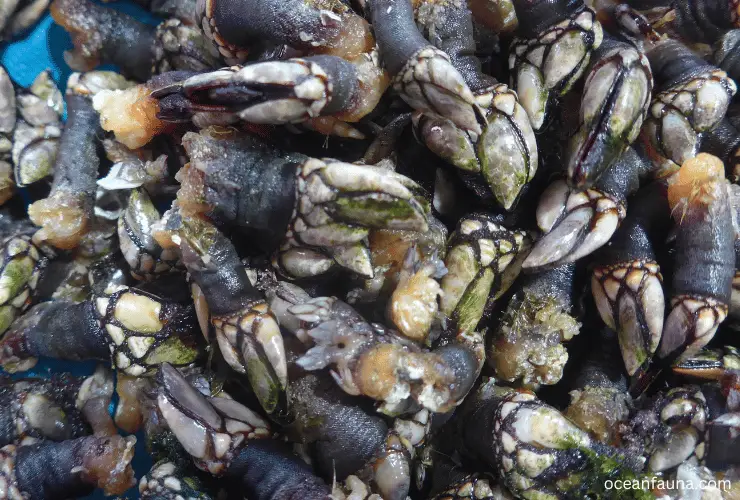
The feeding process of these crustaceans is quite fascinating. The gooseneck barnacles extend their modified legs called cirri into the water, which have a series of hairs that act like a net. As water flows through them, the hairs filter out food particles, which are then transported to the barnacle’s mouth.
It is worth noting that gooseneck barnacles are not picky eaters and will consume any small plant or animal matter that they can filter from the water, including phytoplankton, zooplankton, and detritus. They have even been known to occasionally scavenge other small marine creatures or consume the eggs and larvae of nearby fish.
Furthermore, gooseneck barnacles have a unique feeding habit that involves gathering in large numbers on rocky shorelines to capture the largest amount of food possible. This behavior has allowed them to thrive in the intertidal zone, where they are often found growing in huge clusters, clinging to rocks, logs, and other hard surfaces.
Are Gooseneck Barnacles Parasitic?
In general, gooseneck barnacles under the Pollicipes genus are not considered parasitic. However, there is one exception – the genus Anelasma. Anelasma is a unique type of goose barnacle that lives as a parasite on various shark hosts.
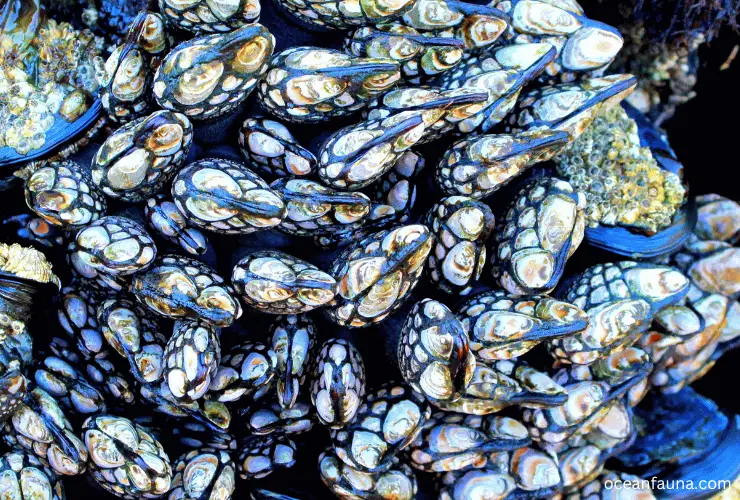
These parasites are found on their host sharks’ skin, gills, and fins. Unlike other gooseneck barnacles that anchor themselves to rocks or other hard surfaces, Anelasma has adapted to live on living hosts.
Anelasma feeds on the shark’s flesh and blood, which can negatively affect the host’s health if the infestation is severe enough. The parasites can cause lesions and wounds that can become infected, leading to tissue damage. It is also possible for the parasites to spread to other parts of the shark’s body and cause further damage.
An important point to mention is that Anelasma is a genus containing only one species. This means that it is the sole known type of gooseneck barnacle that is parasitic.
How Long Do Gooseneck Barnacles Live?
Gooseneck barnacles, known for their unique and elongated shape, are marine crustaceans found clinging to rocks and other hard surfaces along the coastlines of Spain, Portugal, France, and other countries. These barnacles have a relatively long lifespan, living for up to 20 years or more.
The lifespan of gooseneck barnacles largely depends on their environment and food availability. These barnacles are filter feeders, using their cirri – a set of feathery appendages – to capture plankton and other small organisms from the water. Their lifespan is closely related to nutrient levels and overall water quality in their environment.
Gooseneck barnacles not only use their cirri for feeding but also for breathing. These appendages allow them to extract oxygen from the water, making them well-adapted to their marine environment. However, their lifespan may be significantly reduced if their environment becomes compromised through pollution or other stressors.
How Do Gooseneck Barnacles Reproduce?
Gooseneck barnacles have a unique and interesting method of reproduction. They are hermaphroditic, meaning they have both male and female reproductive organs. These organs mature at relatively the same rate in these organisms, allowing them to mate with other barnacles.
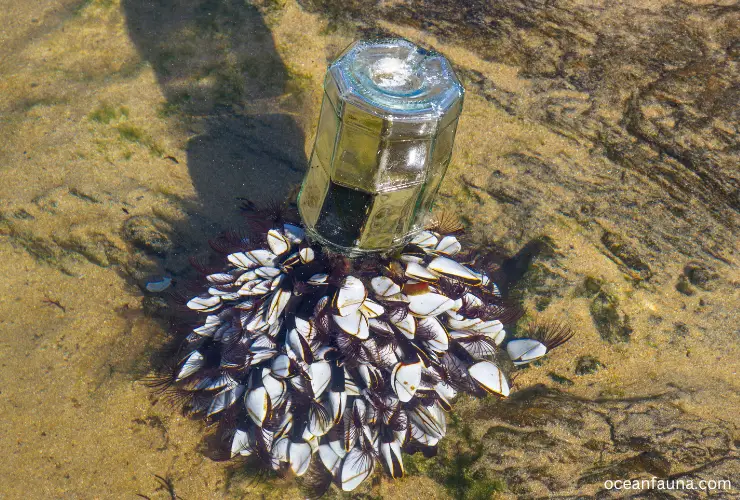
The process starts with the release of sperm and eggs into the water, called broadcast spawning. This can occur when the conditions are right, such as during high tide or on a full moon. The sperm and eggs mix together in the water, and fertilization occurs externally.
After fertilization occurs, the larval stage begins. The larvae swim and drift in the ocean for several weeks until they find a suitable place to settle and attach themselves. Once they attach themselves to a surface, they start to grow and develop into a juvenile barnacle.
As the barnacle grows, it becomes more and more sexually mature. Once it reaches maturity, it will release its sperm or eggs into the water, signaling to nearby barnacles that it is ready to mate. This behavior is called synchronized spawning.
The gooseneck barnacle may self-fertilize if there are no other barnacles within about eight inches. This allows it to reproduce without the need for a mate, ensuring that the species can survive even in areas with low population densities.
Are Gooseneck Barnacles Edible?
Yes, gooseneck barnacles are indeed edible. In fact, they are considered a delicacy in Spain and Portugal, where they are highly sought after for their sweet, succulent flesh. These crustaceans are typically harvested from rocky coastal areas with strong waves and tides, ensuring they are exposed to a steady supply of nutrient-rich seawater.
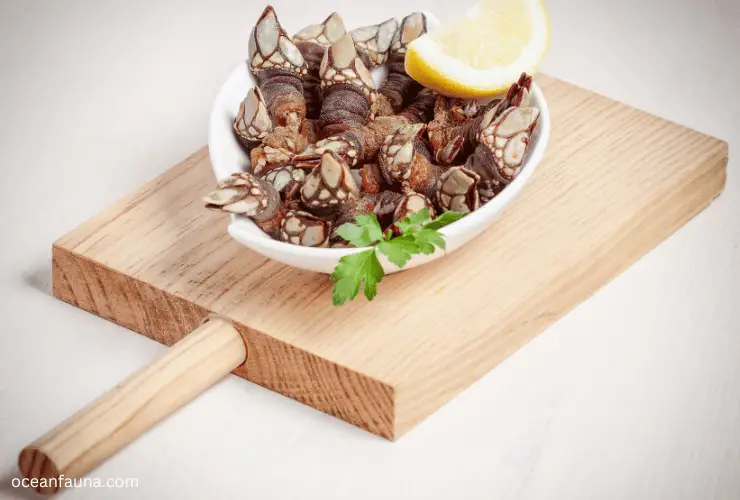
Despite their tough exterior, gooseneck barnacles are surprisingly easy to prepare. They can be boiled or grilled and are often served with a variety of sauces and accompaniments. When cooked properly, the meat is tender and flavorful, with a taste that has been compared to a cross between lobster and clam.
However, it is worth noting that harvesting gooseneck barnacles can be dangerous and challenging. These creatures are found in areas where the surf can be treacherous, and getting to them often requires significant skill and courage.
Additionally, some populations of gooseneck barnacles have been over-harvested in certain regions, leading to concerns about their long-term sustainability.
Are Gooseneck Barnacles Rare?
Yes, gooseneck barnacles are considered rare. They are not commonly found in typical grocery stores due to their limited availability and unique harvesting process. These seafood delicacies are primarily harvested in the spring and fall seasons in Spain and Portugal, where they can be found attached to rocks and other hard surfaces in the ocean.
To harvest gooseneck barnacles, fishermen must brave the rough ocean waters and carefully collect the creatures by hand without damaging them or the surrounding ecosystem. This dangerous and labor-intensive process makes gooseneck barnacles a rare luxury food item enjoyed by seafood enthusiasts and gourmets worldwide.
How Much Does a Gooseneck Barnacle Cost?
A gooseneck barnacle is considered a delicacy in many countries. It is undoubtedly an expensive item on the menu, with a price tag of $51.75 per pound. The high cost of gooseneck barnacles can be attributed to various factors.
Firstly, these barnacles are difficult to harvest as they grow on rocks in the intertidal zone, making them accessible only during low tides. Harvesters put themselves in dangerous situations to retrieve them, which increases the cost.
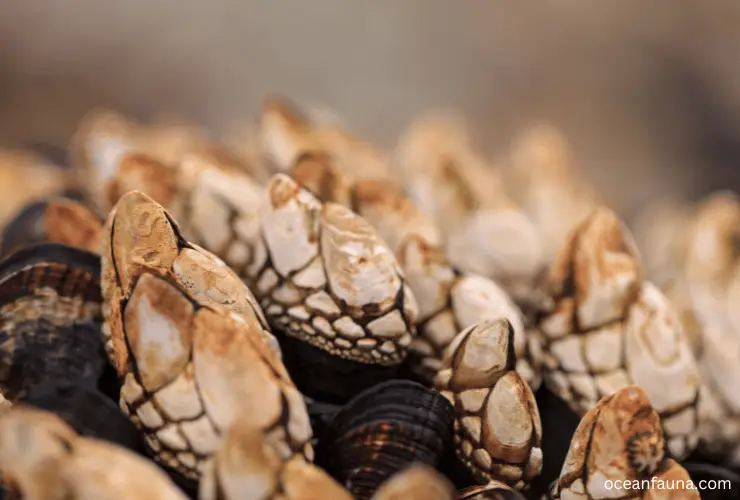
Furthermore, gooseneck barnacles have a unique texture and taste that is difficult to find in other seafood. Their complex flavor profile is described as a combination of sweet and salty with a slight hint of umami. This uniqueness makes them highly sought after by food enthusiasts and chefs.
Moreover, as discussed above, gooseneck barnacles are considered rare in many countries. In Spain, for example, they are known as “percebes” and are considered a delicacy, fetching a high price at markets. The scarcity of these barnacles drives the cost up considerably.
FAQs
How big is a gooseneck barnacle?
Depending on age and species, Gooseneck barnacles typically range from 7-9 cm in size.
Are gooseneck barnacles poisonous?
Gooseneck barnacles are not poisonous. In fact, they are edible and have been harvested by coastal First Nations for a long time. The flesh inside the stalk of the barnacles tastes similar to lobster.
Conclusion
I hope all your doubts regarding gooseneck barnacles are resolved. Here I have discussed the different aspects, such as their habitat, reproduction, edibility, and rarity. These unique and interesting creatures have adapted over time to survive in their marine environment.
If you have any further queries about them, let me know. I will answer them as soon as possible.

